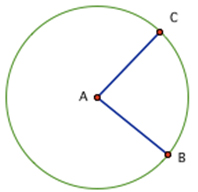
There are two very important relationships between angles and intercepted arcs in circles. The first one is about central angles and their intercepted arcs.

Angle BAC is a central angle with intercepted arc CB. The measure of the central angle equals the measure of its intercepted arc.

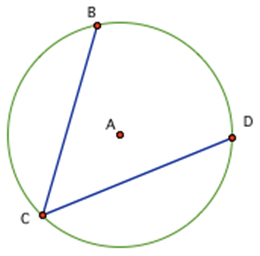
The second relationship is about inscribed angles and their intercepted arcs.
Angle BCD is an inscribed angle with its intercepted arc BD. The measure of the inscribed angle is half the measure of the intercepted arc.

What happens if an inscribed angle and a central angle intercept the same arc on a circle?
![]() Use the interactive below to investigate the relationship between ∠ABC, an inscribed angle, and ∠ADC, a central angle, that both intercept
Use the interactive below to investigate the relationship between ∠ABC, an inscribed angle, and ∠ADC, a central angle, that both intercept  . Click the START button to begin the animation. As the animation progresses, look for patterns in the two angle measures.
. Click the START button to begin the animation. As the animation progresses, look for patterns in the two angle measures.
What relationship do you notice between the measure of an inscribed angle and the measure of a central angle if they intercept the same arc on a circle?
Interactive popup. Assistance may be required.
Replay the animation and look for patterns in numbers that are multiples of 5 of 10.
Interactive popup. Assistance may be required.
The measure of an inscribed angle is half the measure of the central angle if they intercept the same arc on a circle.
When you make a conjecture from patterns that you notice, you are using inductive reasoning to make your conjecture. You can use deductive reasoning to show that your conjecture is true every time.
![]() In the interactive below, drag the reason that best supports the statement in the flow proof of a conjecture that could be made from observing patterns in measures of inscribed angles and central angles that intercept the same arc on a circle.
In the interactive below, drag the reason that best supports the statement in the flow proof of a conjecture that could be made from observing patterns in measures of inscribed angles and central angles that intercept the same arc on a circle.
Suppose you have an inscribed angle whose sides go through the endpoints of a diameter. In other words, the inscribed angle is included in a semicircle. What conjecture can you make about this angle? Let's investigate.
Example 1 |
Example 2 |
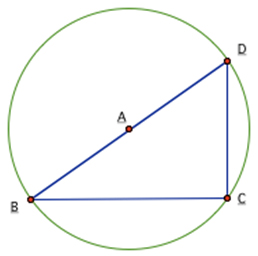 |
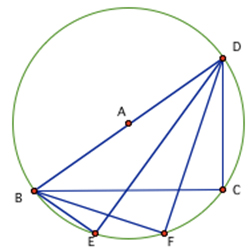 |
Look at example 1. What do you notice? |
Look at example 2. Does the relationship you
noticed in example 1 hold for angles E and F?
(Hint: Use the corner of a piece of paper to check.) |
In your notes, complete the following conjecture and then click on the blanks to check your answer.
Inscribed angles in a Interactive button. Assistance may be required. _______________ semicircle are always Interactive button. Assistance may be required. _______________ right angles.
The conjecture that you just made is based on inductive reasoning. You can use deductive reasoning to show that your conjecture is always true.
![]() In the interactive below, drag the reason that best supports the statement in the flow proof of a conjecture that could be made from observing patterns in measures angles that are inscribed in semicircles.
In the interactive below, drag the reason that best supports the statement in the flow proof of a conjecture that could be made from observing patterns in measures angles that are inscribed in semicircles.
Let's look at another situation where we have inscribed angles that share the same intercepted arc but are not necessarily right angles.
![]() Click on the start button below to compare two inscribed angles that share the same intercepted arc.
Click on the start button below to compare two inscribed angles that share the same intercepted arc.
![]() In the interactive below, drag the reason that best supports the statement in the flow proof of a conjecture regarding the congruency of inscribed angles that share a common intercepted arc.
In the interactive below, drag the reason that best supports the statement in the flow proof of a conjecture regarding the congruency of inscribed angles that share a common intercepted arc.
How does using deductive reasoning to prove a conjecture relate to using a step-by-step thought process?
Interactive popup. Assistance may be required.
Using deductive reasoning allows you to consider each step, one at a time, so that you can use established rules (theorems, postulates, etc.) to show why a conjecture must be true.
Use circle J, shown below, to answer questions 1-3.
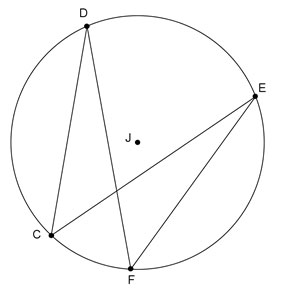
 was 74°. What theorem or postulate supports his conclusion?
was 74°. What theorem or postulate supports his conclusion?
Interactive popup. Assistance may be required.
Is ∠DCE a central or inscribed angle? In a circle, the measure of an inscribed angle is 1 over 2
1
2
the measure of the intercepted arc.
In a circle, the measure of an inscribed angle is 1 over 2
1
2
the measure of the intercepted arc.
Interactive popup. Assistance may be required.
How are angles DCE and DFE related? In a circle, two inscribed angles that intercept the same arc are congruent.
In a circle, two inscribed angles that intercept the same arc are congruent.

Interactive popup. Assistance may be required.
How are angles DCE and DJE related?
Interactive popup. Assistance may be required.
m∠DCE = 74°. ∠DCE is an inscribed angle that intercepts , so m
, so m = 74° because an inscribed angle has an angle measure that is one half the measure of the intercepted arc. ∠DJE is a central angle that also intercepts
= 74° because an inscribed angle has an angle measure that is one half the measure of the intercepted arc. ∠DJE is a central angle that also intercepts  , so its measure is equal to the measure of
, so its measure is equal to the measure of  .
. 
Use circle A, shown below, to answer questions 4 and 5.
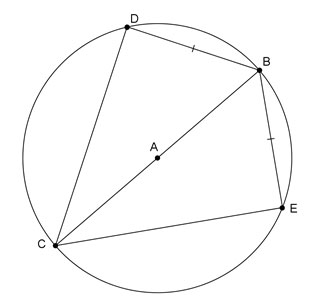
Interactive popup. Assistance may be required.
Which arc does ∠CDB intercept?
Interactive popup. Assistance may be required.
m∠CDB = 90° because it intercepts , which is a semicircle. If an inscribed angle intercepts a semicircle, then it is a right angle, and a right angle has a measure of 90°.
, which is a semicircle. If an inscribed angle intercepts a semicircle, then it is a right angle, and a right angle has a measure of 90°. 
Interactive popup. Assistance may be required.
What type of triangle is ΔDBC? What do you know about the sum of the measures of the interior angles in any triangle?
Interactive popup. Assistance may be required.
∠CDB intercepts a semicircle, so it is a right angle with a measure of 90°. Regina knows that the sum of the interior angles of a triangle is 180°, so she can subtract 180° − 90° − 52° to obtain an angle measure of 38°.